TechRadar Verdict
The Parrot Asteroid Tablet is the best aftermarket option for adding the full range of multimedia functionality to your car we've yet seen. It's a great choice for those who can't fit a double-DIN system to their car, too.
Pros
- +
Lots of features
- +
Great screen
- +
Responsive
Cons
- -
Expensive
- -
Download required for nav functionality
Why you can trust TechRadar
How can you get the latest multimedia tech into your car without the need to spend tens of thousands on an all new motor? Buy yourself a Parrot Asteroid Tablet.
At least, that's what Parrot would have you believe. Parrot pitches the Asteroid Tablet as the complete hands-free, music and connectivity system for your car.
The idea of buying a single device that brings your car bang up to date for multimedia features and functionality including nav, apps, Bluetooth telephony and music is extremely seductive, that's for sure.
From our point of view, the Asteroid Tablet is also intriguing as it's built on Google's Android operating system. The question of whether car makers continue to build their own multimedia ecosystems or allow third party devices to take over more and more functionality is critical.
The Asteroid Tablet provides an answer. But is it any good?
Features
From the user's perspective, the Parrot Asteroid Tablet looks an awful lot like a your common-or-garden aftermarket nav device. It's a small tablet device that sits in a little cradle suckered to the windscreen or stuck to the dash.
But there's much more to the system than that. For starters, the Tablet is actually integrated into your car. Along with the bit you can see literally on the dash, there's an eBox that's fitted out of sight inside it.
Sign up for breaking news, reviews, opinion, top tech deals, and more.
The eBox is actually where a lot of the brains and power of the system are located. There's a 4x 40W amplifier, digital sound processing, noise cancelling and more. We're not fully clear if the eBox houses the processor and memory for the Android-based infotainment platform, thus making the tablet more of a monitor.
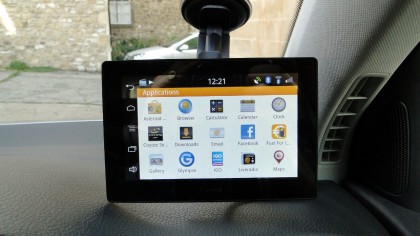
But really, that's moot. The bottom line is that you need both the eBox and the tablet. It's a single package that requires professional installation.
As for the rest, the basics include a 5-inch capacitive touch screen and both wireless and wired connectivity. There's generic USB, a dedicated iPhone connector and an SD card slot.
Regards wireless, both Bluetooth and Wi-Fi are provided. There's no built-in internet connectivity. Instead, you share the connection from your smartphone, which makes sense to us. One less data pack to manage. The Bluetooth connection, of course, provides full hand-free telephony.

Media playback takes multiple forms. You can play music from your smartphone including access to Android and iOS music libraries. You can play music off USB and SD mass storage. Finally, there's streaming radio from the web.
Next up is apps. Parrot has its own dedicated Asteroid market full of apps modified and optimised for Asteroid devices. It's heavy on nav and location based apps like Glympse. But has the usual suspects, too, including Facebook, Twitter and the aforemention streaming music.
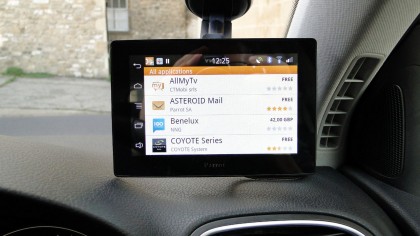
The latter includes Spotify, TuneIn and more. Also part of the app environment is navigation. There's no turn-by-turn nav installed as standard, just Google maps. A number of premium-pay nav apps, like TomTom and iGo Premo are available.
Then there are freebies such as NavFree. Just be aware there's no turn-by-turn out of the box. Finally, everyone favourite video player, VLC, does the movie playback duties via the SD card slot.
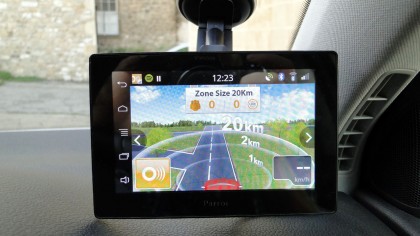
Performance
First up, the touchscreen. It's a capacitive touchscreen, which is a huge relief. There's a line of thinking in some parts of the automotive industry that says capacitive is a bit too sensitive, a bit too flighty for in-car use.
We don't agree with that and it's a pleasure to have a properly responsive touchscreen in-car, not a pig-headed resistive screen that you have to stab at with your fingers.
The interface is reasonably slick and quick to respond, if not anywhere near as sexy as the like of BMW iDrive or Audi MMI. In terms of interface performance, this is no Galaxy S4 or iPhone 5S. But general performance in our time with the device was more than satisfactory and the screen quality is good.
As for internet speeds and performance, that's obviously going to be down to the device you use to feed the data. But scrolling and load times of the web browser look decent enough.
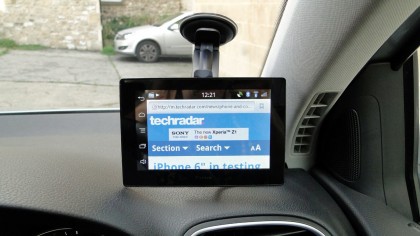
That's a big contrast to the performance of browsers built into some of the latest models. We've experienced the web browsers in Mercedes' COMAND and BMW ConnectedDrive and come away very disappointed.
The browser in the new Mercedes A-Class, for instance, is laughable in terms of performance and scroll. So that's a win for Parrot.
As for navigation, again, that depends on what nav app you go for. TomTom's android app is a well-established favourite, so there's no doubting top quality navigation is available. You'll just have to pay a bit extra for it.
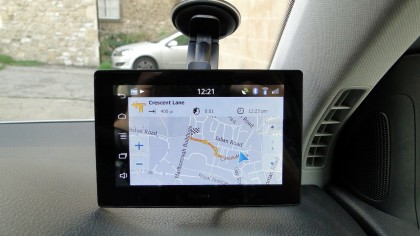
As for the rest of the apps, well, the jury is out. The slight issue is that you need a smartphone to power the internet, so why not just use that for things like Facebook, Twitter and email? Why replicate those functions?
Parrot would argue they give you an interface for those apps that optimised for in-car use. That's true up to a point. And yet the value of the broader app proposition isn't clear.
The final major point regards the user experience and performance is quality of integration. Here your mileage will vary wildly depending on the car it's fitted to.
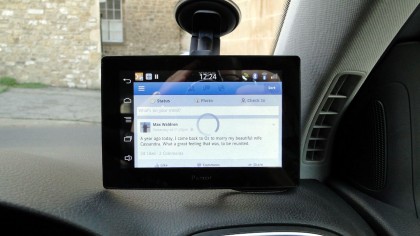
Our test system came in a previous generation VW Golf and the integration was excellent. The system was able to play music from the car's radio, so no loss of functionality there, which is important.
Likewise, where available, the system can be hooked up to shortcut controls on the steering wheel, which is great for both usability and and feeling of polished integration. Too often, kit like this feels horribly jury rigged. Not here.
That said, there's a limit to what Parrot can achieve. Some of the latest and techiest features, like unlocking your car with a smartphone, isn't available. There are some things only factory-fit systems can give you.
Finally, it;s worth noting that installation will typically add around £80 to the £350 demanded for the hardware itself.
Verdict
The Parrot Asteroid Tablet is a great way to get full multimedia functionality including apps, nav and internet services into almost any car.
We liked
The list of the Tablet's pluses is impressive. The breadth of functionality is pretty much just what we'd want from a device like this. Being based on Android means things actually work and many of the key branded apps are available.
Along with the capacitive touchscreen, it also makes for a decently responsive device and a clear, logical interface.
We disliked
It's a relatively easy fix via an app store download, but the lack of turn-by-turn nav out of the box feels like a fairly major omission. The option of a larger screen would be nice, too. Otherwise, the temptation is just to buy a dock for your smartphone and have 75 per cent of the functionality of the Tablet almost for free.
There's also no getting round the fact that there are advantages to factory fit systems, both in terms of functionality appearance. There are simply things an aftermarket setup can't do.
£350 plus an install fee is also a fairly hefty investment in the context of a normal tablet. Then again, it's dirt cheap compared to most factory fit options.
Final verdict
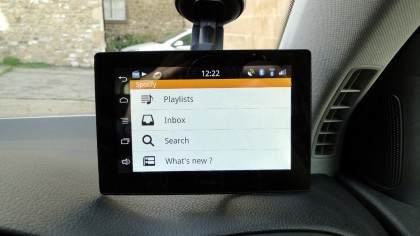
The Parrot Asteroid Tablet is the best aftermarket option for adding the full range of multimedia functionality to your car we've yet seen. It's a great choice for those who can't fit a double-DIN system to their car, too.
Being based on Android brings lots of advantages in terms of performance and interface design and Parrot has mostly made good decisions about how to tweak Android for automotive use. Most of all, it's great to know you can have a major on-the-road tech upgrade without having to buy a new car.
Technology and cars. Increasingly the twain shall meet. Which is handy, because Jeremy (Twitter) is addicted to both. Long-time tech journalist, former editor of iCar magazine and incumbent car guru for T3 magazine, Jeremy reckons in-car technology is about to go thermonuclear. No, not exploding cars. That would be silly. And dangerous. But rather an explosive period of unprecedented innovation. Enjoy the ride.
